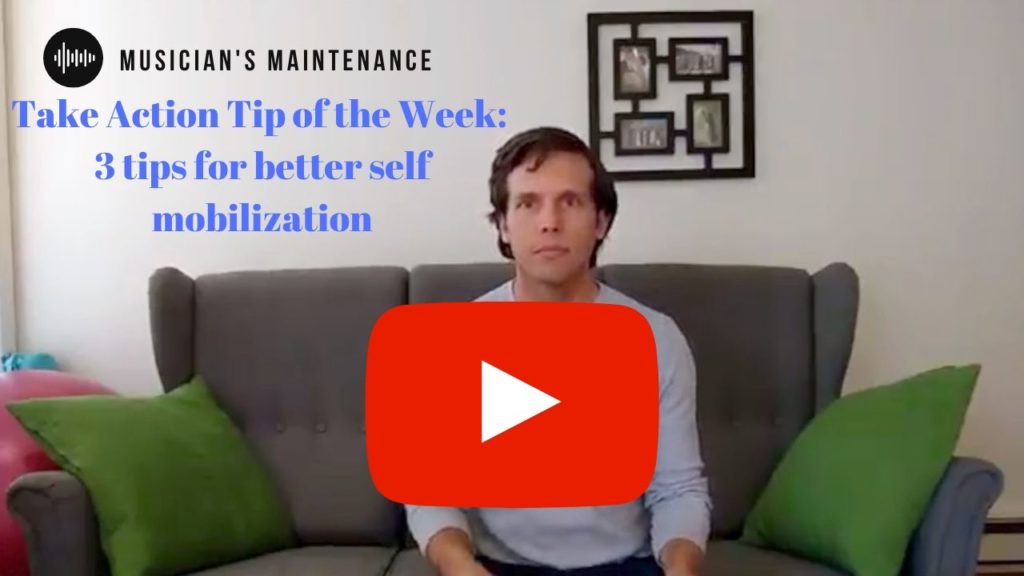I’ve dubbed this month recovery month. At least here at Musician’s Maintenance.
Last week was all about sleep.
This week is all about an active recovery strategy that most musicians know about, but even if they are using it, may not be doing as well as they could be.
Some people call it “self myofascial release” (I don’t. See the second resource below for a nice review of why I’m a fascia skeptic). I just like to call it either self massage or self mobilization.
Essentially it’s using some kind of implement, like a foam roller, rolling pin or ball to find a sore spot and use deep pressure to make it feel better.
When done well, it can be a great drain the cup strategy for the end of the day to recover from the physicality of practice, rehearsal, performance, and life in general.
The resources this week include a study that looks at whether or not self mobilization is effective, an article on why it’s probably not your fascia that you’re mobilizing and a nice article for musicians by a musician on where to start.
I’ve also included a new newsletter feature that I’m calling the Musician’s Maintenance Take Action Tip of the Week. Information is nice, but nothing changes unless you actually do something. So, I’ve made a very short video (3 min) to get you going on self mobilization.
Everything is below.
Enjoy!
P.S. As always if you have feedback, requests for topics you are interested in, or just want to say hi, go ahead and hit reply and your message will go straight to my inbox!
P.P.S. Did someone forward this issue of Musician’s Maintenance to you? I’d love to have you join us by signing up here.
Self Mobilization Study
Before we start mobilizing, we should probably as ourselves the question, does it actually do anything? Here’s a scientific review of 14 studies on foam rolling and self massage to answer that question for us (you can get the full text free with the link if you are a science nerd like me). The research isn’t super strong, but there’s at least consistent evidence that self mobilization can provide a short term increase your range of motion without decreasing muscle performance as well as decreasing the muscle soreness you can get after vigorous activity. So, we can mobilize away and know that we aren’t wasting our time!
The effects of self myofascial release: A systematic Review | International Journal of Sports Physical Therapy
You Probably Aren’t Releasing Your Fascia
You’ll frequently hear self mobilization techniques call self myofascial release. Many health practitioners will also proclaim to perform treatments to release myofascial adhesions. But does your myofascia actually release? If you want a skeptical deep dive on the science, this is a very thorough article detailing the holes in the fascia story. If you are a fascia believer, this article is pretty direct and will challenge your beliefs. I personally think that an accurate understanding of your pain is hugely important and I think that the fascia narrative opens the door to a more passive approach to care where a fascia worker proclaims to to “fix you.” Myofascial techniques may improve how you feel, but maybe not for the reasons that are proposed (I think the techniques affect your nervous system, not your fascia).
Does Fascia Matter | PainScience.com
Where Musicians Should Start with Self Mobilization
Kayleigh Miller is a professional violinist who is doing great work in the world of musician’s health. She recently posted some hints for musicians on how to get started with self mobilization. There’s a little fascia talk, but she also highlights the fact that self mobilization is all about changing the nervous system and the need to match the intensity of the mobilization and the tool you use to what your body needs. Overall it’s a great article to check out if your interested in getting a professional musician’s view on the topic.
Roll it Out | Musicians Health Collective
Tools
There are a ton of different self mobilization tools out there, but in reality, they tend to be fancy, better marketed versions of tennis balls (can of 3 for $3.50). Need something softer, try a racquet ball (can of 3 for $5.99). Need something more firm, you can either pick up a lacrosse ball, which may be cheaper than specific massage tools in a sporting goods store, but over at Amazon this little dense massage ball is similar to a lacrosse ball and only $4.00. (All the links here in the “tools section” are Amazon Affiliate links, meaning if you buy using the link, Musician’s Maintenance gets a small portion of the sale)
Take Action Tip of the Week
Information is nice, but it’s useless unless you do something. Here a 3 min video where I give you 3 self mobilization tips. Two on how to self mobilization better, and one very basic self mobilization to try that I think you’ll like.
Three Tips for Better Self Mobilization
Sharing
Please forward this issue of Musician’s Maintenance on to a friend, teacher, colleague, or any other musician you think may be interested. Thank you!
